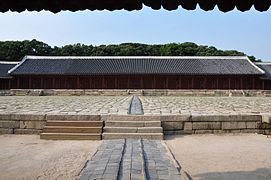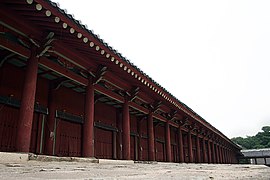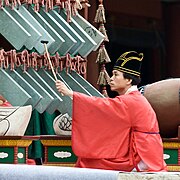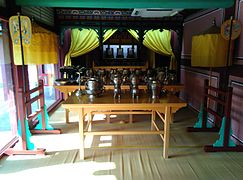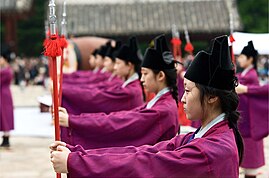Jongmyo
| Jongmyo Shrine | |
|---|---|
|
UNESCO world heritage |
|

|
|
| Jeongjeon Hall of Jongmyo Shrine |
|
| National territory: |
|
| Type: | Culture |
| Criteria : | (iv) |
| Surface: | 19.4 ha |
| Reference No .: | 738 |
| UNESCO region : | Asia and Pacific |
| History of enrollment | |
| Enrollment: | 1995 (session 19) |
Jongmyo is a Confucian shrine in the Korean capital, Seoul . It serves as ancestor worship for the rulers of the Joseon Dynasty , which ruled Korea from 1392 to 1910 and promoted Confucianism in Korea . In 1985 Jeongjeon, the main hall of the shrine, was included in the National Treasures of South Korea with registration number 227 , and in 1995 the entire shrine was declared a World Heritage Site by UNESCO . The ancestral worship ritual and music that is held annually in the shrine were inscribed on the Representative List of the Intangible Cultural Heritage of Humanity in 2008 .
location
The shrine ( location ) is located in the Hunjeong-dong district in the Jongno-gu district of Seoul, south of the two royal palaces Changdeokgung and Changgyeonggung, in a park that originally went through to the palaces. During the Japanese rule , a road was built separating the shrine from the palaces. There are now plans to restore the park continuously.
history
King Taejo (r. 1392–1398), the first king of the Joseon dynasty , moved the capital of the Joseon Kingdom in 1394 from Gaeseong (today's Kaes nachng ) to Hanyang (in today's Seoul ). There he had the ancestral shrine built from October 1394 to September 1395. The main hall of Jeongjeon at that time had seven chambers, each designed to hold wooden plaques commemorating a king and his wife or wives. King Sejong (ruled 1418–50) had Yeongnyeongjeon built in 1421 as a second hall with six chambers. During the Imjin War (1592 to 1598), the Japanese invaders burned down the wooden buildings of the shrine, from 1604 to 1608 they were rebuilt and expanded. The memorial plaques had been hidden in a citizen's house and were moved back to the newly built halls in 1608. Jeongjeon now had eleven chambers and Yeongnyeongjeon ten. Yeongnyeongjeon was expanded to twelve chambers in 1667 and Jeongjeon to fifteen in 1726. In 1836 Jeongjeon was expanded to the present 19 chambers and Yeongnyeongjeon to sixteen.
description
The shrine essentially consists of two halls: the main Jeongjeon hall ( location ) and the secondary hall Yeongnyeongjeon ( location ), which are separate from each other in the park. Both halls are surrounded by a walled rectangular courtyard, which has a larger gate on the opposite side of the hall and a smaller gate in each of the side walls.
Jeongjeon is an elongated hall about 100 meters long. This makes it the longest one-piece wooden structure in traditional style in Korea. Under a canopy supported by wooden posts, the entrances open into 19 chambers in which the plaques of 19 kings and 30 queens are kept. The courtyard in which the hall is located is around 140 meters wide and 90 meters deep. On the entrance side of the courtyard, to the right of the gateway, is the Gongsindang ( Lage ) shrine , in which 83 plaques are kept for deserving subordinates of the Joseon Dynasty, and to the left, Shilsadang ( Lage ), a shrine for the gods of heaven and earth.
Also Yeongnyeongjeon is a long hall, but only about 70 feet long. It has a similar structure to Jeongjeon , but has a slightly raised middle section. The hall has 16 chambers in which the plaques of 16 kings and 18 queens are kept. This includes four generations of Taejo's ancestors and members of the royal family who were posthumously made king or queen. The walled courtyard in which the hall is located is about 90 meters wide and 80 meters deep.
Other smaller buildings are scattered across the park, mostly southeast of the two large halls. These include the Mangmyoru Memorial ( location ), the Gongmingdang ( location ) shrine for King Gongmin of Goryeo , the Hyangdaecheong storage building ( location ) and the hunt area ( location ) where the king waited for the ceremonies to begin. In the south of the park there are also two small ponds ( position 1 , position 2 ) each with a round island in the middle.
rites
Every year on the first Sunday in May, a ritual of ancestor worship called Jongmyo Jerye or Jongmyo Daeje is celebrated in Jongmyo Shrine , accompanied by a procession, singing (Jongmyo Akjang) , music (Jongmyo Jeryeak) and dance (Palilmu) . The ritual is organized by descendants of the royal family. Most of the elements of the ceremony were established in the 15th century and have remained unchanged. The ritual includes greeting the spirits, setting the table for a ritual meal and cleaning the seats, offering three ritual goblets of wine, soliciting blessings from the spirits, clearing the ritual food and saying goodbye to the spirits. It is completed by burning the papers with the prayers used.
World Heritage
The Jongmyo Shrine of Royal Ancestral Worship in Seoul was registered as a cultural heritage site in 1995 on the basis of a resolution of the 19th session of the World Heritage Committee in the list of UNESCO World Heritage. With the Seokguram Temple and the Bulguksa Temple and the Haeinsa Temple, it is one of the first world cultural heritage sites in South Korea, which joined the World Heritage Convention in 1988. The reserve has an area of 19.4 ha .
The reason for the entry states, among other things:
Jongmyo is the oldest and most authentic of the Confucian royal ancestral shrines with a unique spatial arrangement that has been preserved in its entirety. At Jongmyo Jerye, traditional rituals of ancestor worship are still performed, along with the accompanying ritual music and dance performance.
The entry was made on the basis of criterion (iv).
(iv): The Jongmyo Shrine is an outstanding example of a Confucian royal ancestral shrine, which has survived relatively undamaged since the 16th century and whose importance is increased by the preservation of an important part of the intangible cultural heritage in the form of traditional ritual practices and forms .
literature
- The Royal Anchestral Shrine of the Joseon Dynasty . In: Cultural Heritage Administration of South Korea (ed.): World Heritage in Korea . 2011, p. 40-51 (English).
Web links
- Jongmyo Shrine on the UNESCO World Heritage Center website ( English and French ).
- A Brief Note on Jongmyo In: www.jongmyo.net com (English)
- Jongmyo Shrine . In: visitkorea.or.kr, Korea Tourism Organization (English)
- Jongmyo Shrine . In: www.lifeinkorea.com (English)
- Jongmyo Ancestral Shrine . In: www.orientalarchitecture.com (English)
- Jongmyo Shrine In: www.theseoulguide.com (English)
Individual evidence
- ↑ a b c d e Jongmyo Shrine. In: whc.unesco.org. UNESCO World Heritage Center, accessed February 6, 2017 .
- ↑ a b UNESCO: Royal ancestral ritual in the Jongmyo shrine and its music. In: www.unesco.org. Retrieved February 27, 2017 .
- ↑ Jongmyo Shrine. In: english.visitkorea.or.kr. Korea Tourism Organization, accessed February 28, 2017 .
- ^ Jongmyo Ancestral Shrine, Seoul, Korea, South. In: orientalarchitecture.com. Retrieved February 28, 2017 .
- ↑ a b Jongmyo Shrine . In: The Seoul Guide. Online Travel Guide For Seoul, South Korea . ( theseoulguide.com [accessed February 28, 2017]).
- ↑ Jongmyo Shrine. In: www.lifeinkorea.com. Retrieved February 28, 2017 .
- ↑ A Brief Note on Jongmyo. In: www.jongmyo.net. Retrieved February 28, 2017 .
- ↑ Jongmyo Daeje. In: www.jongmyo.net. Retrieved February 27, 2017 .
- ↑ English Jongmyo Shrine , German title according to the World Heritage List. In: Unesco.de. German UNESCO Commission, accessed on February 11, 2017 . with adaptation of the transcription
- ↑ Decision: CONF 203 VIII.C.1. In: whc.unesco.org. UNESCO World Heritage Center, accessed February 8, 2017 .

